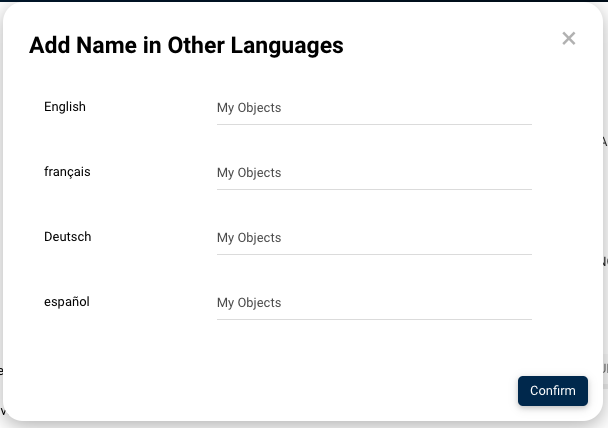The “My Objects” Widget enables users to showcase important items on their widget. These can include processes, parts of processes, and associated objects. This makes it easy for users to keep an eye on and access objects that are important for their job right from their Home Page. You can also use this widget to manage objects assigned to other roles, resources, groups, or assets in the organization.
In this topic, we’ll explore the general functionalities and how to access the customizable settings of this widget.
Functionalities of the Widget
- The widget displays the object’s name, type, status, subtype, and the date of the last modification.
- Click on the
icon to navigate to its graph page.
- Click on the name of the object to navigate to its details page.
- To move the widget, click and hold it, then drag it to your preferred location in the page.
- To resize the widget, hover over the bottom right corner, click the double-pointed arrow (
), and drag to the desired size.
- To remove any widget from the home page, click on the ellipsis menu and select “Remove widget”
- To access the settings parameters of the widget, select “Settings”
Settings of the Widget
When clicking on the “Settings” option, a pop-up window will be generated.
General
- Name: Customize the name of the widget.
- Globe Icon (
) – Name Translation: Customize the widget name in all supported languages within EPC or your organization. Switching between interface languages will automatically update the widget name.
- Upon clicking the globe icon, a pop-up will appear as shown below. Input the corresponding name translation for each language.
- Upon clicking the globe icon, a pop-up will appear as shown below. Input the corresponding name translation for each language.
- Title color: Select the preferred widget title color using a specific hex code or the color picker.
- Title size (px): Specify the title size in pixels.
- Title icon: Choose the desired adjacent icon from Font Awesome’s V5 version collection. Copy its HTML code and paste it into this text box. Please ensure to remove the extra HTML code at the beginning and the end, keeping only the icon’s name, as shown below.
- Object Type: This is the primary filter when customizing this widget. It should be set first, as all subsequent items are derived from the selected object type. For example, if you wish to exclusively showcase process objects, you can opt for “end, gateway, intermediate, process, process set, start, and task”. By default, all object types are pre-selected when adding the widget to the home page.
- Object Sub-Type: Users can use sub-types for refined filtering, focusing on specific object types. Admins define these sub-types and are linked to objects through their properties. Each object can be assigned a single sub-type. While multiple sub-types can be selected for one object type, the sub-type field will be disabled if multiple object types are chosen, as variations may exist.
- Categories: Objects can hold multiple assigned categories to meet business needs. Categories act as labels for object classification. For instance, to group international processes and business reports, apply the “International” and “Business” filters. Note that one object can have multiple categories. Thus, users can select various object types for efficient filtering.
- Displayed Content: Users can filter the widget based on object status.
- Show Latest: Displays in-progress (draft) and published content.
- Published Only: Displays only published content.
- User Profile Setting: Content display changes based on the user’s chosen mode, whether “Latest” or “Published,” selected through the toggle button. If the user is in “Latest” mode, the widget will reflect the “Show Latest” option. If the user is in “Published” mode, the widget will reflect the “Published Only” option.
- Hide Name: To hide the widget’s name when viewed in the home page, click this checkbox.
My Options
- Assigned me to as: Users are assigned roles by EPC Modelers for effective process organization and governance. Individuals can hold multiple roles, depending on the organization’s versatility. Your assigned resource and role(s) will be visible in this section.
- My RASCI-VS: This filter helps you sort your assigned roles and resources, prioritizing them according to your involvement in the RASCI-VS Matrix. This lets you create widgets based on your engagement level. The less RASCI-VS values you select, the more focused the widget’s content will be.
The RASCI-VS selection will be locked until a user has selected a role or resource in the “Assigned to me as” section. Once done, they can then apply this filter. - Filter for My Favorites: When users select this checkbox, the widget will exclusively display objects favorited by the user, streamlining their access to preferred content.
- Filter for My Subscriptions: To help users in prioritizing information, selecting this checkbox will exclusively display objects to which the user is subscribed, ensuring focused access to relevant content.
More Options
- Assigned to: Enables users to access objects linked to particular roles, resources, org units, and assets. This offers insight into the connections between different individuals and roles within the organization. Using this filter will extend the scope an individual user can have within the organization.
- Assigned to as: This filter serves as an expansion of the “Assigned to” filter, enabling additional categorization of objects based on the RASCI-VS Matrix. Through this filter, users can access supplementary objects, understand their connections, and grasp the nature of their relationships.
It’s important to note that this filter remains inaccessible until a user has correctly selected an object in the “Assigned to” filter.
Need more help with this?
Visit the Support Portal



 icon to navigate to its graph page.
icon to navigate to its graph page. ), and drag to the desired size.
), and drag to the desired size.



